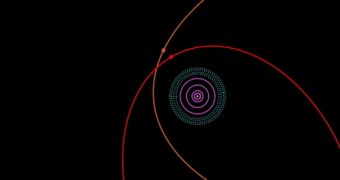Two astronomers from the Carnegie Institution for Science (CIS) led a team of experts that was just recently able to discover the existence of a new dwarf planet at the outer edges of the solar system. This finding again brings the need to study the outer fringes of the solar system in more detail, and establish the latter's boundaries with more accuracy.
The newly discovered object has been designated 2012 VP113, and was discovered in the inner Oort Cloud, a group of comets and other frozen bodies located nearly a light-year away from the Sun. Estimates place the beginning of the Cloud at 50,000 astronomical units (AU) away. An AU is the mean distance between Earth and the Sun, or 157 million kilometers (93 million miles).
The team led by CIS astronomers Scott Sheppard and Chadwick Trujillo was able to identify the dwarf planet using the Gemini Observatory. This installation features two, 8.19-meter (26.9-foot) telescopes, one installed on Mauna Kea, in Hawaii, and the other on Cerro Pachón, in Chile. Researchers say that the object was discovered beyond what are now accepted as the edges of the solar system.
In all likelihood, this is just one in thousands of such rocky, frozen bodies orbiting the Sun. They are basically relics left behind by the formation of the solar system, some 4.6 billion years ago. Since this material did not coalesce with existing planets, asteroids, or Kuiper Belt objects, they were cast out of the inner solar system, and sent to fend for themselves in the Oort Cloud.
One of the most interesting conclusions the team arrived at in the new study was that a planet some 10 times larger than Earth must exist in the Oort Cloud. This prediction was made based on distortions discovered in 2012 VP113's orbit. The hypothetical world may also be influencing objects in the inner Oort Cloud, sending comets and other celestial bodies towards the inner solar system.
“This is an extraordinary result that redefines our understanding of our Solar System,” explains the Director of the CIS Department of Terrestrial Magnetism, Linda Elkins-Tanton. Details of the research were published in the March 27 issue of the top scientific journal Nature.
Previously, the most distant known dwarf planet in our solar system was Sedna, located about three times farther away from the Sun than Neptune. Its aphelion, or point where it is farthest from the Sun, reaches an estimated 937 AU. The new study determined 2012 VP113 orbits well beyond Sedna.
“The search for these distant inner Oort cloud objects beyond Sedna and 2012 VP113 should continue, as they could tell us a lot about how our Solar System formed and evolved,” Sheppard concludes.

 14 DAY TRIAL //
14 DAY TRIAL //